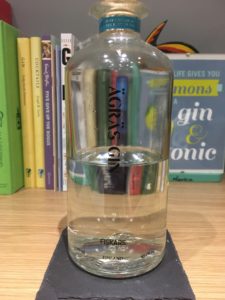 Today’s gin hails from Finland; the Ägräs gin distillery is in Fiskars Village, an old ironworks village 88km west of Helsinki. The distillery takes it’s name from the ancient Finnish god of vegetation, and they use just four botanicals (juniper, red clover, angelica and lemon peel) sourced from the forests of Finland. The distillery is the first crowdfunded distillery in Finland, with over 500 shareholders and now make their gin, an Akvavit, and the limited edition Abloom gin which takes their standard gin mixed with hibiscus flowers and honey.
Today’s gin hails from Finland; the Ägräs gin distillery is in Fiskars Village, an old ironworks village 88km west of Helsinki. The distillery takes it’s name from the ancient Finnish god of vegetation, and they use just four botanicals (juniper, red clover, angelica and lemon peel) sourced from the forests of Finland. The distillery is the first crowdfunded distillery in Finland, with over 500 shareholders and now make their gin, an Akvavit, and the limited edition Abloom gin which takes their standard gin mixed with hibiscus flowers and honey.
gin and tonic
Avva Gin
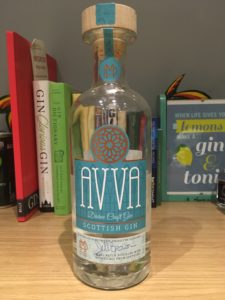 I’ve admired the bottle of Avva gin for a while, and truth be told it’s been sat on my shelf for nearly two years thanks to my old housemate bringing me a bottle home from one of her events. Based in the old cathedral city of Elgin (up the top near Lossiemouth) the Moray Distillery uses botanicals selected from the highlands and Speyside (including red clover, dandelion and nettle) to create their small batch gin. Avva means a respected grandmother from the Indian language of Dravidian, but in Hebrew it means to overturn or ruin – combined they make a nod to the traditional mother’s ruin reputation. Their still is made in Speyside and is named Jessie Jean after the founder’s grandmothers. The love of the local area continues into their branding, the label features the ‘rose window’ which is an idea of how the cathedral’s round window would have looked when it was still standing.
I’ve admired the bottle of Avva gin for a while, and truth be told it’s been sat on my shelf for nearly two years thanks to my old housemate bringing me a bottle home from one of her events. Based in the old cathedral city of Elgin (up the top near Lossiemouth) the Moray Distillery uses botanicals selected from the highlands and Speyside (including red clover, dandelion and nettle) to create their small batch gin. Avva means a respected grandmother from the Indian language of Dravidian, but in Hebrew it means to overturn or ruin – combined they make a nod to the traditional mother’s ruin reputation. Their still is made in Speyside and is named Jessie Jean after the founder’s grandmothers. The love of the local area continues into their branding, the label features the ‘rose window’ which is an idea of how the cathedral’s round window would have looked when it was still standing.
Fidra Gin
Note: I contacted Fidra to ask for a sample and a chat about where my family are from in Scotland, even though they’re based near the family home, I’ll tell you exactly what I think of the gin
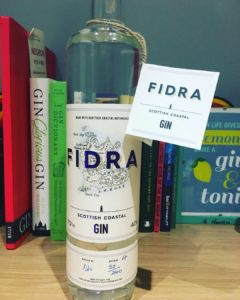 For those of you that know your Scottish islands, you might know of Fidra off of the coast of East Lothian. Fun fact – my Dad grew up near the border of East Lothian and we spent many a summer holiday eating ice cream on the beach in Musselburgh which is just along the coast. Emma and Jo set up Fidra Gin after their passion for gin developed and they wanted to showcase botanicals grown on the East Lothian coast. The botanicals used include sea buckthorn, elderflower, lemon thyme and rosehip, all handpicked from the local area. The proximity to the sea allows the botanicals to impart a slightly salty taste to the gin and their love for their area carries through to their branding, a beautiful tall, thin bottle with a label depicting the region. So, how does it taste?
For those of you that know your Scottish islands, you might know of Fidra off of the coast of East Lothian. Fun fact – my Dad grew up near the border of East Lothian and we spent many a summer holiday eating ice cream on the beach in Musselburgh which is just along the coast. Emma and Jo set up Fidra Gin after their passion for gin developed and they wanted to showcase botanicals grown on the East Lothian coast. The botanicals used include sea buckthorn, elderflower, lemon thyme and rosehip, all handpicked from the local area. The proximity to the sea allows the botanicals to impart a slightly salty taste to the gin and their love for their area carries through to their branding, a beautiful tall, thin bottle with a label depicting the region. So, how does it taste?
Biggar Gin
Note: I contacted Biggar for a sample and they kindly sent me one to try, as always I’ll let you know what I think.
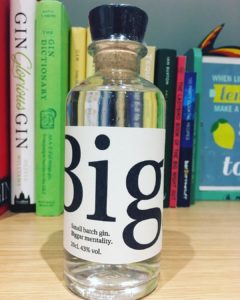 Biggar gin is one of the many new brands coming from Scotland, started by two brothers who focus on small scale production with big ambitions. They take their name from the town they grew up in, south of Glasgow and Edinburgh in the Southern Uplands and distil their gin at the famous Strathearn Distillery. Traditional botanicals juniper, coriander seeds, cardamom and orris root combine with rosehip, rowan berries and lavender. The idea behind the botanicals is to create a balance of flavours – sweet meets savoury, florals meet earthiness – which reflects the local landscape. So, how does it taste?
Biggar gin is one of the many new brands coming from Scotland, started by two brothers who focus on small scale production with big ambitions. They take their name from the town they grew up in, south of Glasgow and Edinburgh in the Southern Uplands and distil their gin at the famous Strathearn Distillery. Traditional botanicals juniper, coriander seeds, cardamom and orris root combine with rosehip, rowan berries and lavender. The idea behind the botanicals is to create a balance of flavours – sweet meets savoury, florals meet earthiness – which reflects the local landscape. So, how does it taste?
TBGC Strawberry & Balsamico Gin
Note: The team at Maverick Drinks sent me a bottle to try out on the blog, but as always I’ll let you know what I really think.
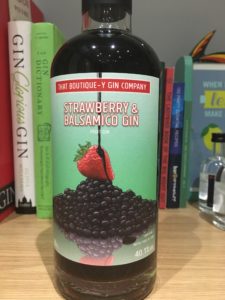 I’m going to be super honest up front: this does not sound like my cup of tea. That Boutique-y Gin Company have decided the best combination to match with gin is strawberry and balsamic vinegar. Now, don’t get me wrong, I like strawberries, I like balsamic vinegar, and I like the two together. But as a gin? They say the combination of the three works perfectly, a mix of syrupy, sweet and savoury together. They make it by creating separate distillates of black pepper, strawberry and Aceto di Balsamico tradizionale di Modena DOP aka the fanciest balsamic you can get your hands on and which is geographically protected a la Champagne. Not only does it have to be made in the province of Modena, but is has to also be aged for between 12 and 25 years in small barrels which gives the gin an oaky quality which balances the sweeter, fruity notes. They suggest having it on its own, with tonic or with prosecco – I’m a big fan of mixing sweeter liqueurs with prosecco, so perhaps this will be the winner for me.
I’m going to be super honest up front: this does not sound like my cup of tea. That Boutique-y Gin Company have decided the best combination to match with gin is strawberry and balsamic vinegar. Now, don’t get me wrong, I like strawberries, I like balsamic vinegar, and I like the two together. But as a gin? They say the combination of the three works perfectly, a mix of syrupy, sweet and savoury together. They make it by creating separate distillates of black pepper, strawberry and Aceto di Balsamico tradizionale di Modena DOP aka the fanciest balsamic you can get your hands on and which is geographically protected a la Champagne. Not only does it have to be made in the province of Modena, but is has to also be aged for between 12 and 25 years in small barrels which gives the gin an oaky quality which balances the sweeter, fruity notes. They suggest having it on its own, with tonic or with prosecco – I’m a big fan of mixing sweeter liqueurs with prosecco, so perhaps this will be the winner for me.
Ginvent 2018 – Scapegrace Gold Gin
 Happy Christmas Eve! It is with great sadness that we bring Ginvent to an end for yet another year, but before we do we need to try Scapegrace Gold gin. Scapegrace gin comes from New Zealand, when one guy married the other guy’s sister and discussed how they would like to make their own gin. 13 botanicals and a load of debt later, they had a gin that won gold in London and San Francisco. They use glacial water from the southern Alps mixed with orange and lemon peel, nutmeg, cloves and dried tangerine to make their classic 42% gin. Scapegrace Gold is their navy strength version at 57% which builds layers of citrus with orange, lemon and tangerine. So let’s see how it tastes.
Happy Christmas Eve! It is with great sadness that we bring Ginvent to an end for yet another year, but before we do we need to try Scapegrace Gold gin. Scapegrace gin comes from New Zealand, when one guy married the other guy’s sister and discussed how they would like to make their own gin. 13 botanicals and a load of debt later, they had a gin that won gold in London and San Francisco. They use glacial water from the southern Alps mixed with orange and lemon peel, nutmeg, cloves and dried tangerine to make their classic 42% gin. Scapegrace Gold is their navy strength version at 57% which builds layers of citrus with orange, lemon and tangerine. So let’s see how it tastes.
Ginvent 2018 – Pothecary gin
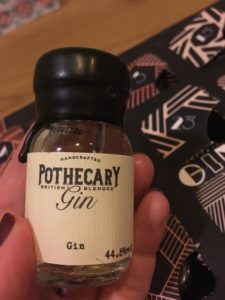 We’ve made it to the penultimate day of Ginvent. Sad face. Today we drink Pothecary gin, which I tried after meeting the team at Junipalooza earlier this year. You can read my thoughts on it here.
We’ve made it to the penultimate day of Ginvent. Sad face. Today we drink Pothecary gin, which I tried after meeting the team at Junipalooza earlier this year. You can read my thoughts on it here.
You can get your hands on a 50cl bottle from Gin Kiosk for £39 (at the time of writing). You can find them on Facebook, Twitter and Instagram.
Let me know your thoughts on Twitter and Instagram, and catch up with all things Ginvent here.
Ginvent 2018 – Malfy Gin
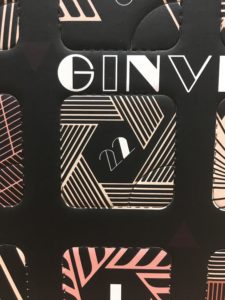 Final three days! Today we drink Malfy gin, an Italian gin with a lovely label. Most accounts of gin history trace the roots back to the Dutch genever, but Malfy claim that gin was invented by monks on the Salerno coast and their distillery in Moncalieri has been established since 1906. The key flavour for Malfy gin is the Italian lemons that grow in Sicily and the Amalfi coast. These lemons give the gin it’s freshness, alongside Italian grown juniper and fresh spring water. Since launching, they have grown their range to include four varieties – the Originale that we are drinking today which actually came second and is more juniper forward than the original the Con Limone which makes the most of the fresh lemons, the Con Arancia using Sicilian blood oranges, and the Gin Rosa which features pink grapefruit and Italian rhubarb. So, how does it taste?
Final three days! Today we drink Malfy gin, an Italian gin with a lovely label. Most accounts of gin history trace the roots back to the Dutch genever, but Malfy claim that gin was invented by monks on the Salerno coast and their distillery in Moncalieri has been established since 1906. The key flavour for Malfy gin is the Italian lemons that grow in Sicily and the Amalfi coast. These lemons give the gin it’s freshness, alongside Italian grown juniper and fresh spring water. Since launching, they have grown their range to include four varieties – the Originale that we are drinking today which actually came second and is more juniper forward than the original the Con Limone which makes the most of the fresh lemons, the Con Arancia using Sicilian blood oranges, and the Gin Rosa which features pink grapefruit and Italian rhubarb. So, how does it taste?
Ginvent 2018 – Salcombe Start Point Gin
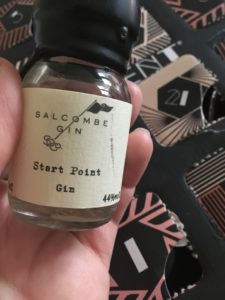 With four days left to go, we’ve hit the third gin that I’ve already reviewed (this is impressive that we have so few this far in). Today’s gin is Salcombe Start Point gin, and you can read all my thoughts here.
With four days left to go, we’ve hit the third gin that I’ve already reviewed (this is impressive that we have so few this far in). Today’s gin is Salcombe Start Point gin, and you can read all my thoughts here.
You can get a 70cl bottle of the 44% gin from Gin Kiosk for £37.40 (at time of writing). You can find them on Facebook, Twitter and Instagram.
Let me know what you think on Twitter and Instagram, and don’t forget to keep up with all things Ginvent here.
Ginvent 2018 – Cuckoo Gin
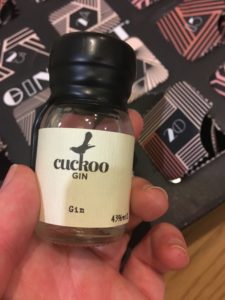 We’ve done remarkably to make it to 20 December before hitting another gin I’ve tried. Today’s gin is Cuckoo gin which I am a big fan of – you can read what I thought over here.
We’ve done remarkably to make it to 20 December before hitting another gin I’ve tried. Today’s gin is Cuckoo gin which I am a big fan of – you can read what I thought over here.
You can buy a 70cl bottle of 43% gin from Gin Kiosk for £38.00 (at time of writing). You can find Cuckoo on Facebook, Twitter and Instagram.
Have you tried Cuckoo gin? Let me know your thoughts on Twitter and Instagram. Don’t forget to keep up with all things Ginvent here.